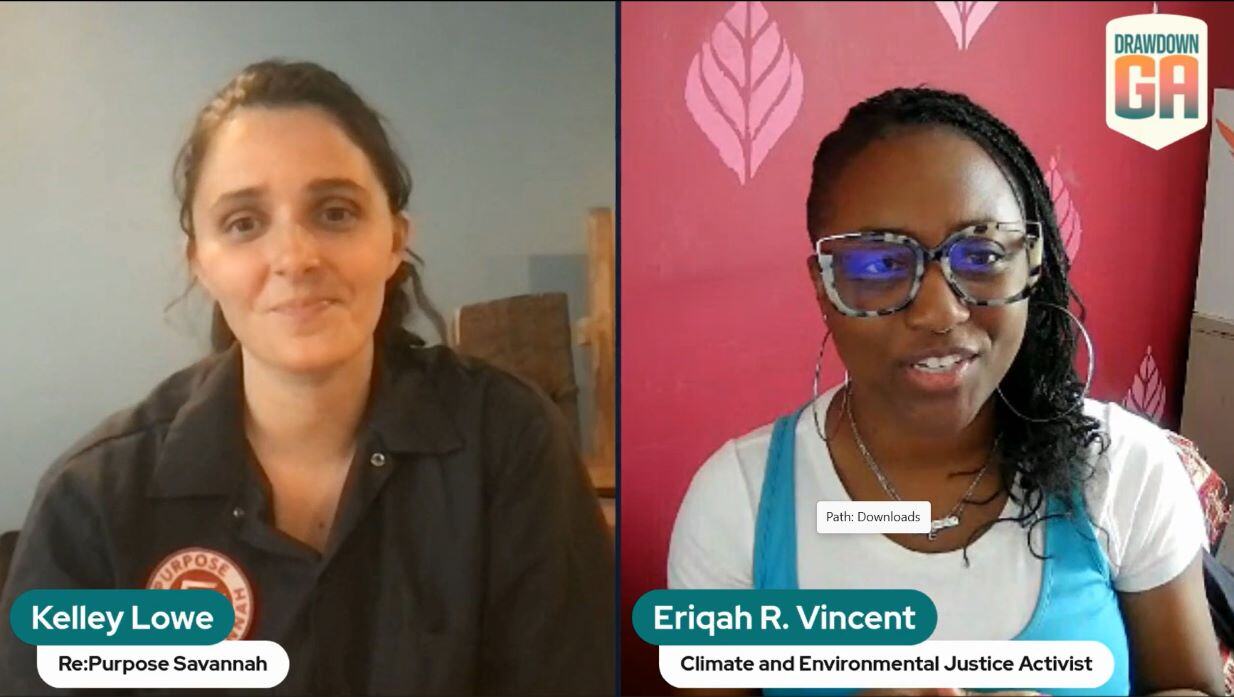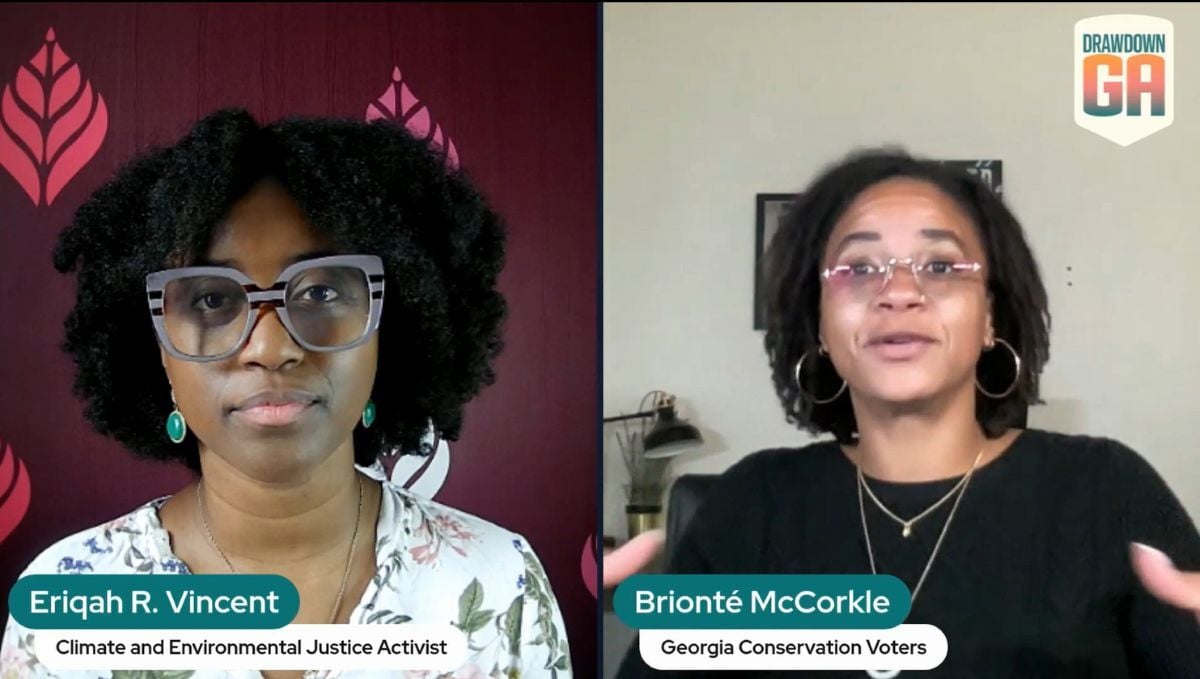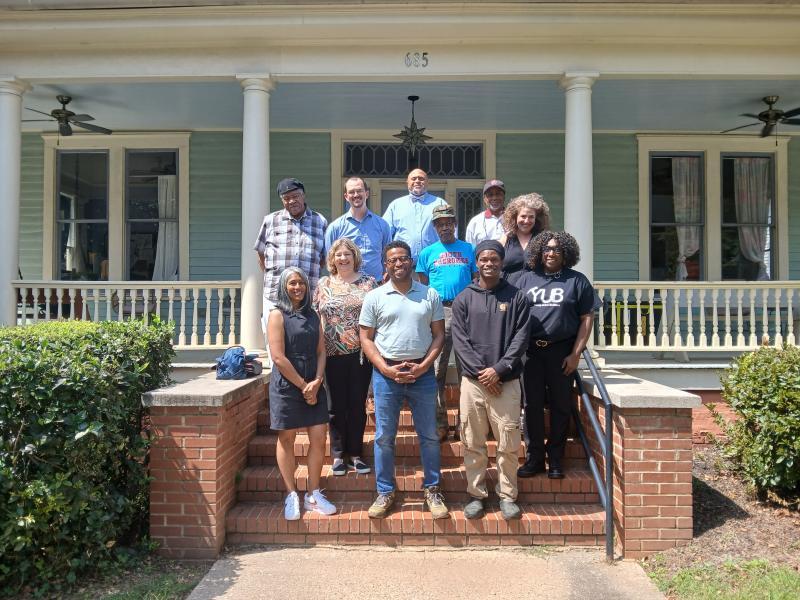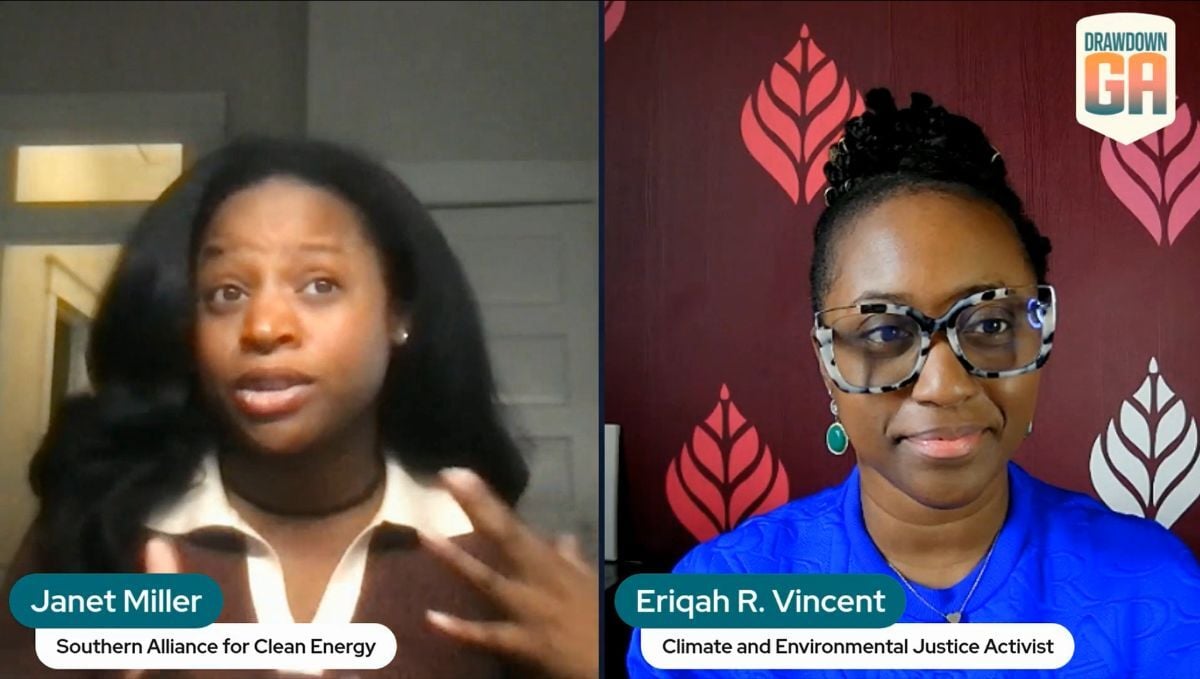Recycled building materials--those that are reclaimed when a building is deconstructed rather than demolished-- play an important role in reducing emissions and air pollution and uplifting communities.
It’s a topic that Kelley Lowe, director of salvage at Re:Purpose Savannah, is deeply passionate about.
In this interview in the Georgia Climate Digest video series, Eriqah Vincent of Drawdown Georgia speaks with Kelley about the path that led the Fine Arts major to a career in deconstruction and recycled building materials, and the many benefits of reclaiming these materials, from environmental to cultural to economic.
Kelley also shares how you can support the work of Re:Purpose Savannah and the movement to reclaim building materials in your community.
Recycled Building Materials Interview and Highlights
Highlights:
Kelley speaks about the issues of sustainability around recycled building materials. [10:36 - 12:27]
Eriqah and Kelley explore the environmental justice aspects of deconstruction vs. demolition [17:02 - 18:29]
Hear how the Georgia climate community can help support the movement to recycle more building materials. [30:42 - 33:00 ]
A lightly edited transcript follows:
Kelley Lowe of Re:Purpose Savannah Discusses Recycled Building Materials
Eriqah Vincent: We're really excited today to have Kelley Lowe from Re:Purpose Savannah. We would all love to hear more about you and the fantastic work that you all are doing at Re:Purpose Savannah. What led you to such an interesting, varied career path?
Kelley Lowe: Yeah, it was not a linear route by any means. I grew up overseas; my parents both worked with the State Department, so I had the great fortune to live in different countries and be immersed in international communities. Moving around a lot helps you adapt to new environments and glean many different perspectives. I mostly grew up in Europe, so I was surrounded by great art and great architecture, and I went to school for fine art in the U.S.
I'd always wanted to experience what living in the U.S. was like, so I left Paris for Richmond, Virginia. I thought it was awesome. It was a culture shock--a very different mentality and way of living, but I thought that there was an interesting dichotomy between what felt like a really fast-paced consumer culture and people digging deep to have impactful change and meaningful conversations and projects and programs.
While I was at art school, I noticed that we were making a bunch of artwork but that we were also throwing a lot into our dumpsters. I felt confused and conflicted about the expenditure of resources, time, and material to make art that ends up in a gallery, and then the same materials, just arranged differently, end up in a landfill.
Getting Started at Re:Purpose Savannah
I made my way to Re:Purpose Savannah during the pandemic years. Things were obviously changing and shifting all over the world. I'd always considered myself an artist, but I just didn't really have the ego to do that, and I cared deeply about science, the planet, and sustainability.
And here was this company that was thinking about things with a lot of care and a lot of love and was offering an alternative to demolition by deconstructing buildings and then harvesting all the usable materials--96% of a building is still usable for the most part.
Re:Purpose Savannah was run by a group of women, who are underrepresented in this industry and didn't fit the standard image of a construction worker. We were all from different areas with different backgrounds, but it turns out we can all use a crowbar and appreciate beautiful construction, our heritage, and our built environment.
They needed someone with some sales experience. What I had was an ability to adapt, problem-solve, and connect clients with product options. I cared about the mission because there's too much valuable material going into landfills as a result of construction and demolition. We focus on historic buildings because that’s the nature of the city that we're in.
These buildings were made of materials that don't exist anymore. The trees that were cut down were, for the most part, from old-growth forests, which now represent a very small fraction of forestland in this country. But those old trees still exist in our built environment, so honoring them by saving them, by being good stewards to allow them to have a longer life, is really important.
The Birth of Re:Purpose Savannah
Eriqah: I think that's a beautiful way to think about how we interact with our built environment. You talked a little about Re:Purpose Savannah, and I would love to dig more into that. Why focus on building materials? How do you source them? Who is reusing them?
Kelley: Sure. Re:Purpose Savannah was born out of an older nonprofit called Emergent Structures, which was founded by Scott Boylston, who was the chair of Design for Sustainability at the Savannah College of Art and Design.
He collaborated with folks in academia, circularity, and the built environment and started this nonprofit to analyze the viability and feasibility of circularity with building materials. Re:Purpose Savannah was born out of that as a real boots-on-the-ground business that put theory and academia into practice.
For six years, we have provided the service of deconstruction. Much like a demolition company, we will get hired to deconstruct a building at the end of its lifetime. Because we are a 501(c)3, the materials that we recoup, for the most part, act as a donation to our nonprofit.
The Deconstruction Industry
Deconstruction as an industry is not super well known across the U.S. Historically, it's what we have been doing since the dawn of time. It was only after World War II that all these land-moving machines came back, and it was easier to remove a condemned building entirely than fix it up. Demolition has become the new norm. The industry isn’t even 100 years old, but here we are.
People are starting to understand what we do, but to your point, it's challenging to get jobs. The way that we get these deconstruction contracts is by property owners caring about their buildings. A lot of the buildings that we take down have been in families for a while, so there's sentiment attached to them.
Alternatively, it's people who have an interest in sustainable building practices and people who are interested in the tax deduction. So we've been able to compete with demolition.
Demolition is faster and cheaper, right? What we do is carefully un-build a building. It takes time. It's not two days with a backhoe, and the building's gone. We spend months, sometimes, unbuilding these buildings.
The Climate Impacts of Recycled Building Materials
A third of the world's waste is from construction and demolition. In terms of real change that we can make to reduce emissions globally, it's a really important place to start. Most of the buildings in the US are made of lumber.
Reclaimed lumber is one of the most sustainable building materials you can use. It's sequestered carbon. The embodied carbon is a lot lower than a new tree that needs to get cut down, milled, kiln-dried, shipped, packaged, and sent to Home Depot.
We are taking buildings apart in Savannah that have reached the end of their lifecycle. And the materials are going back into the renovation of and sometimes even new buildings in Savannah. During the pandemic, it was interesting because a lot of supply chains were getting disrupted all over the place, but we still had wood. It was still there.
We're only capturing a small amount of it, but we're doing a lot more work, and we're gaining a lot more traction. There are six cities in the U.S. that have deconstruction ordinances that mandate that in order to obtain a permit, deconstruction has to be done outright or at least considered.
Eriqah: I find it fascinating that a third of the world's waste is building materials. It's one of those things. It's obvious but not obvious. I think that's an interesting tidbit that you mention there.
Kelley: Yeah, it is shocking. You know, you expect to see a dumpster outside of a renovation job, right? And sometimes you see dumpsters outside of new construction--what are they doing? There are opportunities for us to get better at what we do.
Focusing on the Next Generation in Climate Work
Eriqah: I'd love to hear why you're so passionate about reuse and sustainability and more about what got you interested in this type of work.
Kelley: I care about sustainability because it aligns with preservation in my mind. I've been able to have such rich experiences in cities that have preserved cultural aspects, environmental aspects. I care a lot about the world we live in and how beautiful it is. I love beauty and I want us to proceed with care and thoughtfulness.
I also have a young son, a seven-month-old baby. I’d like the world to be beautiful for him, and we have the ability to do it. We were building incredible buildings before we had electricity at the ready, and now we have all these technologies at our fingertips. I'm just a caring person. I care a lot.
Eriqah: I have a three-year-old, and I feel the same way about my work. I just want her to be in a world that has beauty, is not wasteful, and is also just. It’s important for us to care a little bit more about the place that both of our kids and the next generation are going to inhabit long after us.
Kelley: There's a lot of wrong that goes on, especially in demolition. It's not only that the building materials are getting wasted, but when you crush a building that's full of potentially toxic materials, all of it is going into the air or into the water or soil.
And more often than not, the buildings that are getting demolished are in disadvantaged communities. Especially in Savannah, you can see that where this is happening, it shouldn't be happening. It shouldn't be happening anywhere.
Eriqah: I think that is where our two worlds collide. You're thinking about the construction of buildings in the most sustainable way and deconstruction rather than demolition, which is a beautiful way to put that.
Then you're talking about asbestos and other materials getting into the air and the groundwater, and that's where environmental justice comes in. How are we properly disposing of things to make sure they aren't affecting underserved communities? It's all cyclical. It's all coming back around, and it's all connected.
So I'd love to ask you another question. How specifically does the reuse of lumber and other building materials help to reduce greenhouse gas emissions?
Greenhouse Gas Emissions and Old vs New Growth Lumber
Kelley: The average U.S. home has 14,000 board feet of lumber, which is a lot. When you think about how much lumber already exists in the environment but is no longer serving its first intended purpose--it's a lot of wood. And it contains a lot of carbon, especially with old-growth lumber. It would take a second-growth forest 200 years to recoup all the carbon that the old-growth lumber already sequestered.
Reclaimed lumber is one of the best green building solutions. It's readily available, and especially the old growth lumber, it's got a strength and the resiliency that new lumber doesn't, so it does inherently last a lot longer. A two-by-four from a turn of the century building is a lot different in size and weight than a new one because the trees are getting grown a lot quicker and cut down a lot faster. If we were to let our forests grow a little slower, it would be really interesting to see what would happen as a result of that in terms of emissions.
We have too many usable materials going into the landfill, and then as they rot, they release GHGs back into the air. It's very wasteful.
We have to be creative in the way that we reuse materials because a lot of building codes don't allow for perforated lumber to be used structurally. For example, if 2x4s already have nails in them.
So that means that we have to be creative with the ways that these materials can be reused. They absolutely can be reused structurally. You just need a structural engineer to sign off on them.
It allows for really exciting projects. We end up building a lot of furniture. A lot of our lumber goes back into renovations and restorations. So it's not full structural builds, instead, it’s things like foundation repairs, wall repairs, and siding repairs.
We like to think about our materials as organ donors for other buildings, especially when we’re using historic materials that will inherently last a lot longer. It's much better for these old buildings than using new materials.
A Typical Workday With Recycled Building Materials
Eriqah: What does a typical workday look like for you at Re:Purpose Savannah?
Kelley: The beginning of my day involves putting on my steel-toed boots and going to the lumber yard, which is where we receive and process the vast majority of the building materials that come off of a deconstruction job site. Sometimes I will start the day by visiting a deconstruction job site.
When I first started with the company, I was out in the field, on roofs, taking stuff apart, and it was amazing. I'm a little bit older now, and I've got a son, so I've got to be careful. But I would visit a deconstruction job site to see what's happening, what's getting harvested. If I can anticipate what materials are coming back, I can start finding homes for them immediately.
Because the materials are so varied, I get to play matchmaker. I'm calling contractors, designers, architects, saying, “Hey, we're going to be getting this batch of two-by-eight joists. Any interest?” I will then go to the lumberyard to check on how our processing of what we already have is going and then check on custom orders.
We have a woodshop so we are also transforming these materials into things that people who aren't necessarily restoring or buying a house or building a house can access. Then I will check in with our sales department to see what deals need to be made, and what products need to move.
We work with a lot of general contractors in town, and we're also invested in working with affordable housing. Occasionally we're able to really reduce the price of our materials and get them into affordable housing projects while also building a $6,000 custom table for someone. Both options help us navigate it all.
We salvage building materials, but we also salvage trees that come down. I love wood. There are historic trees here, too. So we will get those delivered to our lumber yard, and we'll process them, and they're beautiful. So again, usable, carbon-rich material that should not go rot in the landfill--like a 300-year-old live oak.
So that's kind of a typical day. And then I'll run a machine or I'll work in the woodshop. I'll drive the forklift around. We wear a lot of hats. I'm managing people, but I like to get dirty, too, and make stuff.
Eriqah: You mentioned being an artist, I think it's really beautiful when you can utilize those talents in spaces like this. That's great.
Kelley: I feel like taking a building down is the best form of performance art. I love everyone that I work with, it's a tight-knit community. We trust each other. We rely on each other.
What we do isn't easy. It's hard work to take the building apart and take this stuff out with your hands and your body, and then process the lumber. You have to get all of the metal out of the lumber. And that can be a grueling, painstaking job.
I have to give it up for the crew who works in over 100-degree heat and works tirelessly to do this even though it's really hard. It's wonderful that we get to work with these historic buildings. We also learn the histories of the people that lived there and we preserve them. on our website, you can see we document the histories of the buildings. We get them 3D scanned, So they're not lost. They can still be accessed. We have a lot of reverence in what we do.
How the Georgia Climate Community Can Promote Recycled Building Materials
Eriqah: How can the Georgia climate community support the work that Re:Purpose Savannah is doing in the practice of more sustainable deconstruction, demolition, and construction practices in our state?
Kelley: Just say the word deconstruction a lot, tell all your friends. If you have projects yourself, consider reclaimed second-hand building materials first. In Georgia, we're really lucky. There are a lot of pretty heavy hitters in the reclaimed second-hand building materials industry, like the Lifecycle Building Center in Atlanta.
Those are two great ways, but you can also get involved in local policy. We are trying to pass an ordinance in Savannah that would make it illegal to demolish a building that's over 50 years old. To get a demolition permit, you'd have to be evaluated and if the building could be a viable deconstruction project, that's what it needs to be.
Six cities are doing it already. Portland was the first. They've been able to have huge impacts in their city. Portland has historically had a big reuse community anyway. There's no reason why more cities, especially on the East Coast, couldn't do that. Savannah would love to be the first city in the Southeast to have a deconstruction ordinance. It just makes too much sense.
Deconstruction has environmental benefits, health benefits, cultural benefits, and it creates jobs. So tell your local officials that you care about it and vote for people who support it.
The Climate Work, Both Small and Large, Giving Kelley Hope
Eriqah: So my last question: what is giving you hope around climate solutions in our state? We always like to end with a hopeful note in our conversation.
Kelley: I spend a lot of my time just working and doing the grind and keeping my head down. But when I can pop up and look around, I'm seeing more businesses that have sustainability at the core of what they do. So that gives me hope, that individuals are making a go for it and really believe in it.
I’m also seeing more investments in community-based projects, programs, and businesses. It feels as though people are starting to focus on what's around them and the people that they can most directly impact. We have a few nonprofits in Savannah that give me a lot of joy.
Loop It Up Savannah is a nonprofit that gives children donated art supplies and offers free after-school programs. And then there's a Refillery in Savannah, where you can go and get soap in a bottle that you already have.
These small initiatives give me hope, and then, on a larger scale, the Inflation Reduction Act gives me a lot of hope. We're applying for the Trees Across Georgia Grant, which is a part of that. The Georgia Forestry Council gives me a lot of hope because they are investing a lot in urban forestry management and the planting of more and more trees and training.
I'm hopeful, but there's still a lot to be done.
Eriqah: Thank you so much, Kelley, for caring so much about this work. And thank you to Re:Purpose Savannah for the work that all of you are doing. As somebody who is trying to reduce my carbon footprint and be less wasteful, I admire it deeply. Thank you.
Subscribe for Future Interviews + Insights on Climate Solutions in Georgia
Our next interview, featuring Dory Larsen of the Southern Alliance for Clean Energy, will take a deep dive into the benefits of EVs and the important work being done in our state to ensure that electric mobility lifts up historically disadvantaged communities, too.
Subscribe now to the Georgia Climate Digest to receive this and future Georgia Climate Digest video interviews right in your inbox, along with updates about our progress on climate solutions. Click the button below to subscribe.









